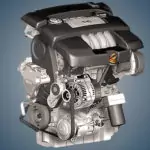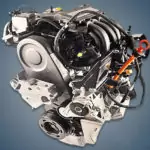The 1.6-liter Volkswagen BGU engine was produced by the concern only from 2003 to 2005 and was installed on PQ35 platform models such as the VW Touran, Golf 5, Skoda Octavia and Seat Altea. This is a Euro 4 unit with an absolute pressure sensor instead of a mass air flow sensor and equipped with a secondary air system and EGR.
The EA113-1.6 series includes: AEH, AHL, AKL, ALZ, ANA, APF, ARM, AVU, BFQ, BGU, BSE, BSF.
Specifications
| Production years | 2003-2005 |
| Displacement, cc | 1595 |
| Fuel system | injector |
| Power output, hp | 102 |
| Torque output, Nm | 148 |
| Cylinder block | aluminum R4 |
| Block head | aluminum 8v |
| Cylinder bore, mm | 81 |
| Piston stroke, mm | 77.4 |
| Compression ratio | 10.5 |
| Features | EGR, EPC |
| Hydraulic lifters | yes |
| Timing drive | belt |
| Phase regulator | no |
| Turbocharging | no |
| Recommended engine oil | 5W-40 (approval: VW 502 00 or VW 505 00) |
| Engine oil capacity, liter | 4.5 |
| Fuel type | petrol |
| Euro standards | EURO 4 |
| Fuel consumption, L/100 km (for VW Touran 2004) — city — highway — combined |
10.9 6.2 7.8 |
| Engine lifespan, km | ~340 000 |
The engine was installed on:
- Audi A3 2 (8P) in 2003 – 2005;
- Seat Altea 1 (5P) in 2004 – 2005;
- Seat Toledo 3 (5P) in 2004 – 2005;
- Skoda Octavia 2 (1Z) in 2004 – 2005;
- Volkswagen Caddy 3 (2K) in 2003 – 2005;
- Volkswagen Golf 5 (1K) in 2004 – 2005;
- Volkswagen Golf Plus 1 (5M) in 2004 – 2005;
- Volkswagen Touran 1 (1T) in 2003 – 2005.
Disadvantages of the VW BGU engine
- This is a simple design and reliable engine, it worries only at high mileage.
- Most often, it is scolded for an oil burner due to the occurrence of rings, but this is closer to 200,000 km.
- There is a lot of trouble here in the ignition system: the contacts are oxidized, the coil is cracking.
- According to the manuals, the timing belt changes every 90,000 km, and when it breaks, the valves bend.
- Often the exhaust manifold and the plastic tee of the cooling system burst.






